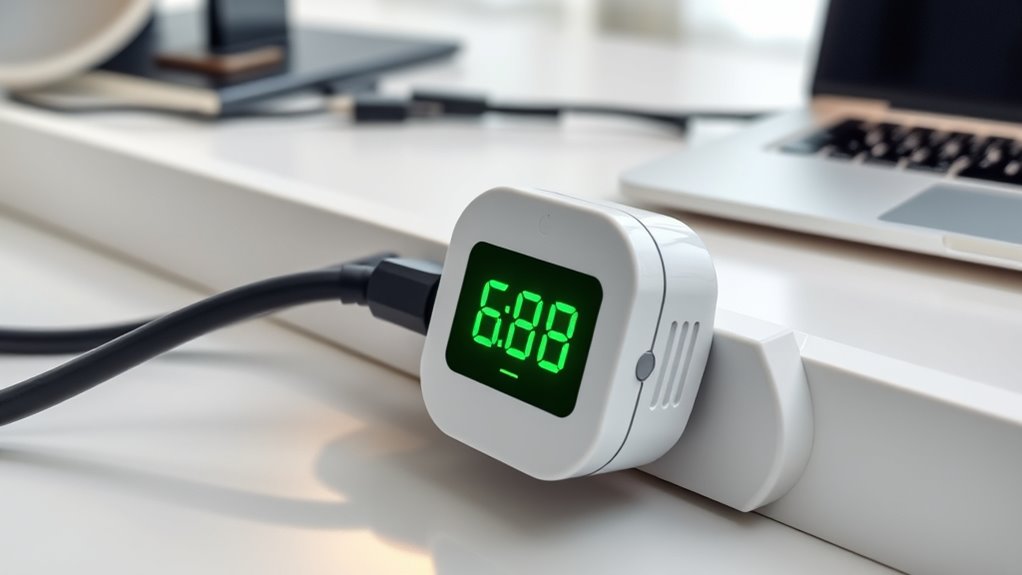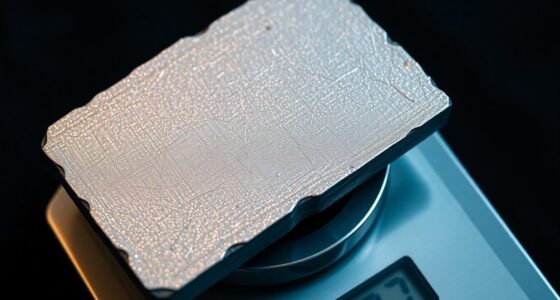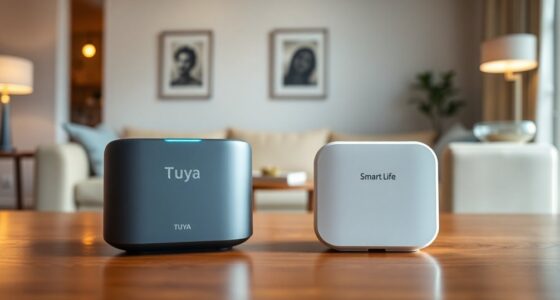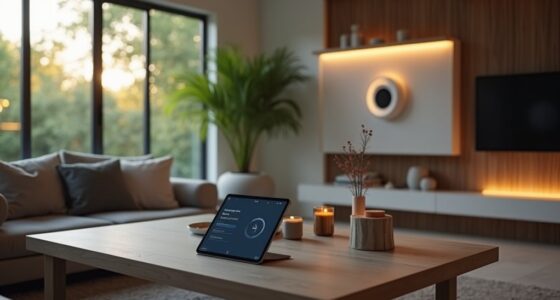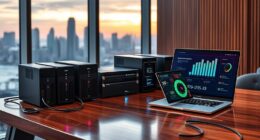To set up your energy monitoring plug, start by gathering all de necessary equipment and choosing a safe, accessible outlet. Plug in the device securely, then download the compatible app for your smartphone, create an account, and connect the plug to your Wi-Fi network following the app instructions. Once connected, customize the device settings and start tracking your energy usage. Keep exploring the setup process to guarantee efficient operation and maximize your energy savings.
Key Takeaways
- Gather necessary equipment and check outlet safety before connecting the device.
- Ensure device compatibility and securely plug it into a suitable power outlet.
- Download the manufacturer’s app, create an account, and connect the device to Wi-Fi.
- Configure device settings, personalize energy management options, and update firmware regularly.
- Use the app to monitor energy usage, troubleshoot issues, and maintain device security.
Gathering Your Equipment and Preparing the Space
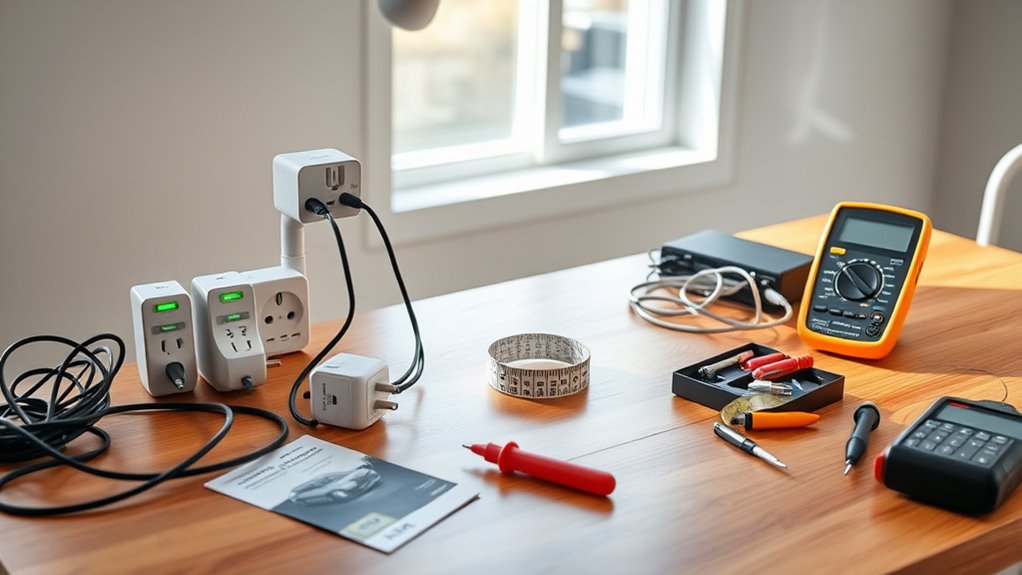
Have you gathered all the necessary equipment before you start monitoring your energy usage? You’ll need your energy monitoring plug, a compatible device, and possibly some extension cords. Before plugging in, check your power outlet placement to guarantee easy access and avoid overloading circuits. Proper cable management is essential to keep your space organized and safe. Use cable clips or ties to route cords neatly, preventing tripping hazards and making it easier to monitor your energy consumption. Clear the area around outlets so you can connect devices without hassle. Planning your layout ahead of time helps you avoid clutter and ensures your equipment functions correctly. Being prepared with organized cables and strategic outlet placement sets a smooth foundation for effective energy monitoring, especially considering power outlet placement influences overall safety and efficiency.
Choosing the Right Energy Monitoring Plug for Your Needs
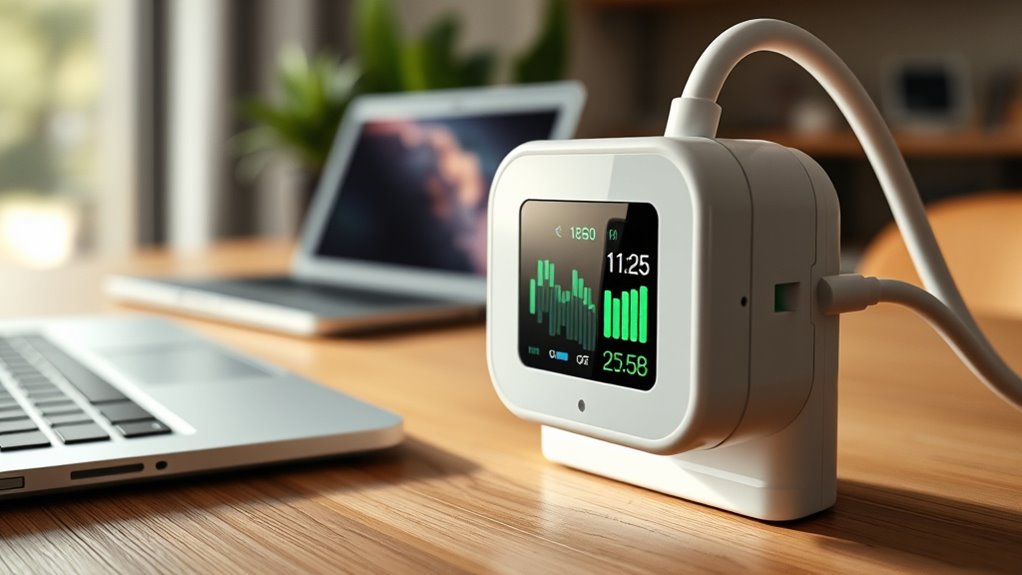
When selecting an energy monitoring plug, you need to take into account whether it’s compatible with your devices to ensure accurate readings. Look for key features and metrics that match your goals, like real-time usage or cost estimation. By focusing on these points, you can find a plug that fits your needs perfectly. Additionally, choosing a model with reliable performance can help prevent inaccuracies caused by electrical or mechanical issues.
Compatibility With Devices
Choosing the right energy monitoring plug depends heavily on confirming compatibility with your devices. First, check device compatibility to verify the plug works with your appliances’ plugs and voltage requirements. Some plugs support only specific socket types or voltages, so double-check these before purchasing. Additionally, consider smart home integration if you want seamless control through platforms like Alexa, Google Assistant, or Apple HomeKit. Not all energy monitoring plugs are compatible with every smart ecosystem, so ensure your preferred system is supported. This guarantees you can easily monitor and control your devices via your smart home setup. Also, reviewing the toilet functionality can help ensure your bathroom fixtures work efficiently alongside your energy monitors. By focusing on both device compatibility and smart home integration, you’ll select a plug that fits your needs and enhances your automation capabilities.
Key Features and Metrics
To select the right energy monitoring plug, it’s essential to understand the key features and metrics that indicate performance and suitability for your needs. Focus on power consumption data to identify energy-hungry devices and optimize usage. Device compatibility ensures the plug works seamlessly with your appliances and smart home systems. Look for real-time monitoring, historical data, and user-friendly interfaces to make informed decisions. The table below highlights these features:
| Feature | Description | Benefit |
|---|---|---|
| Power Consumption | Measures energy used over time | Helps reduce costs |
| Device Compatibility | Works with various appliances | Ensures versatility |
| Real-Time Monitoring | Provides instant data | Enables immediate adjustments |
| Historical Data | Tracks usage patterns | Aids long-term savings |
Choosing the right plug hinges on understanding these key features. Additionally, considering data-driven strategies can help you optimize device efficiency and reduce overall energy consumption.
Connecting the Plug to a Power Source
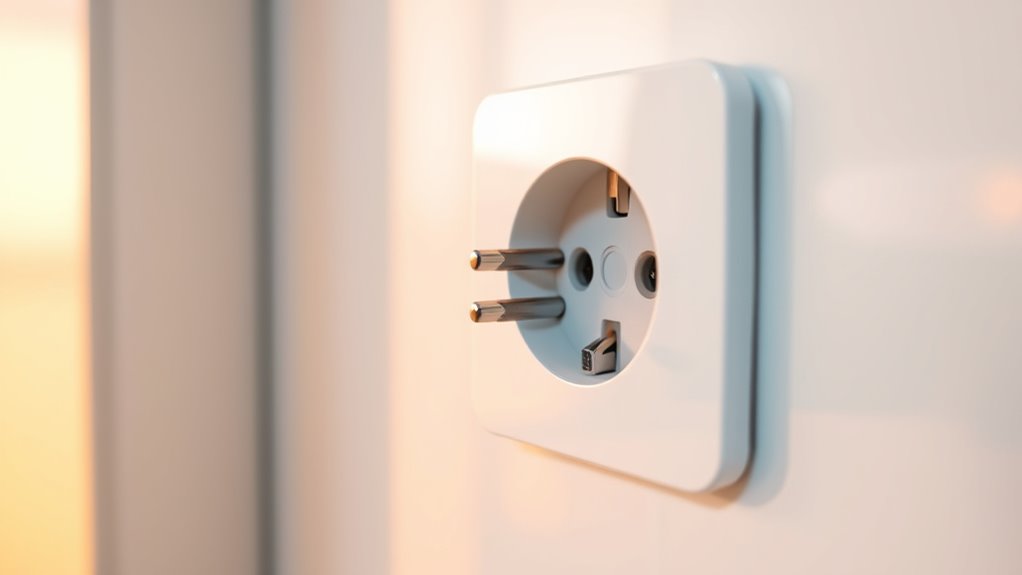
Have you ever wondered how easy it is to set up your energy monitoring plug? First, locate a suitable power outlet nearby. Make sure it’s in good condition and meets electrical safety standards to prevent any hazards. Simply plug the device into the outlet, ensuring it fits securely. Avoid forcing it in or using damaged outlets. Once connected, check that the plug is firmly seated to prevent loose connections that could cause sparks or overheating. Remember, always prioritize electrical safety when handling plugs and outlets. If your plug has an indicator light, verify that it turns on, confirming a proper connection. Additionally, understanding electrical safety standards can help prevent potential hazards. With this simple step, you’re ready to move on to the next phase of your setup.
Downloading and Installing the Corresponding App
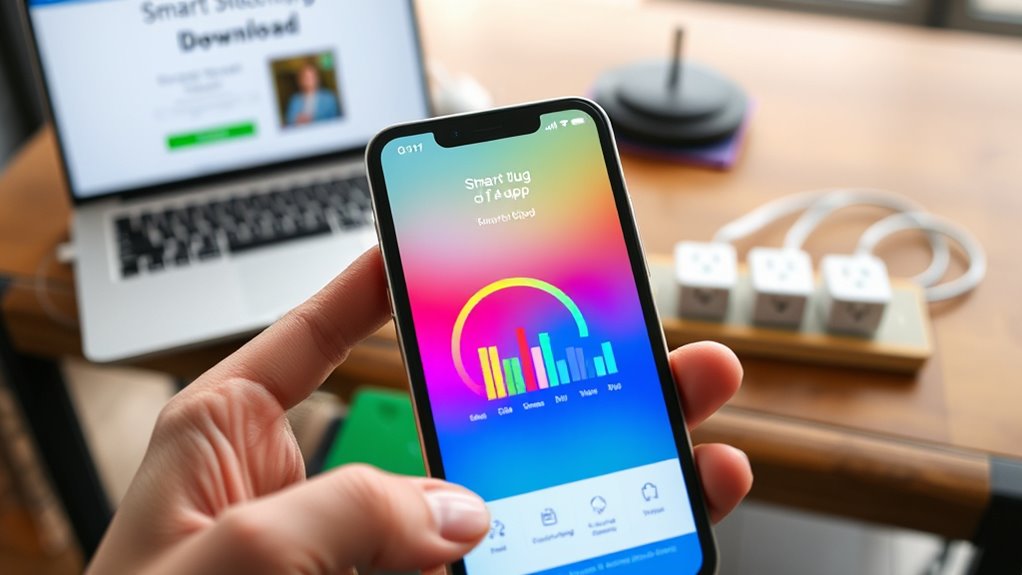
Once your energy monitoring plug is securely connected, the next step is to download and install the corresponding app. This app grants features like real-time energy tracking, usage analytics, and alerts, helping you monitor your devices efficiently. To get started: 1. Find the app in your device’s app store by searching the manufacturer’s name. 2. Confirm your device compatibility by checking the app’s supported operating systems. 3. Download and install the app, then open it to prepare for setup. Pay attention to app features that suit your needs, such as scheduling or remote control options. Verify your device compatibility to avoid any issues during installation. Once installed, you’ll be ready for the next setup step. Hydrocolloid technology promotes healing by drawing out impurities and is a key factor in the effectiveness of acne patches.
Registering and Setting Up Your Account
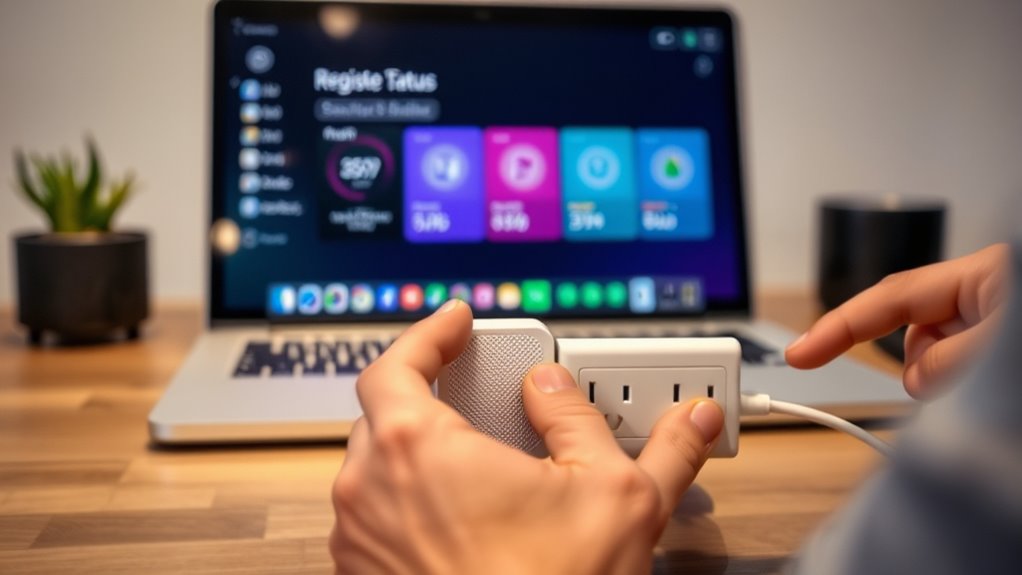
To start using your energy monitoring plug, you’ll need to create an account by entering your details. Make sure to verify your email address to activate your account fully. Finally, set up your payment method so you can manage subscriptions or purchase additional features easily. Using a hybrid approach to your setup can optimize your energy management and ensure compatibility with various devices.
Account Registration Process
Getting started with your energy monitoring plugs is straightforward; the first step is to create your account. This process guarantees you can easily track energy efficiency and seamlessly integrate your devices. To begin:
- Download the dedicated app and open it on your device.
- Tap “Sign Up” and enter your email, creating a secure password.
- Verify your email to activate your account and connect your plugs.
- Remember to review your privacy and consent settings to ensure your data is handled according to your preferences.
Once your account is set up, you’ll gain access to real-time energy data and device integration features. This setup helps you monitor your energy consumption more effectively, making it easier to identify savings opportunities. Keep your login details handy, and you’ll be ready to start optimizing your energy use immediately.
Verifying Email Address
After signing up and entering your details in the app, the next step is to verify your email address. This step guarantees your account security and confirms your identity. Check your inbox for a verification email from the service. Click the link provided to complete the email verification process. If you don’t see the email, look in your spam or junk folder. Once verified, your account is more secure, preventing unauthorized access. Some platforms may require re-verification if you change your email address later. Below is a quick overview:
| Step | Action |
|---|---|
| Check email inbox | Find the verification email |
| Click verification link | Confirm your email address |
| Complete verification | Enable full account access and security |
Following these steps keeps your account protected and ready for use. Being aware of privacy and cookie usage helps you make informed decisions about your account security and browsing experience.
Setting Up Payment Methods
Have you completed your email verification? Now, it’s time to set up your payment methods. Ensuring secure payment security is essential, so choose trusted billing options. Here are three key steps to get started:
- Link your preferred payment method, like a credit card or PayPal, ensuring it’s secure.
- Review billing options to select the plan that fits your needs, whether monthly or annual.
- Confirm your details, double-checking for accuracy to prevent payment issues.
Make sure to verify that your payment setup aligns with recommended security practices to protect your information.
Connecting the Plug to Your Wi-Fi Network
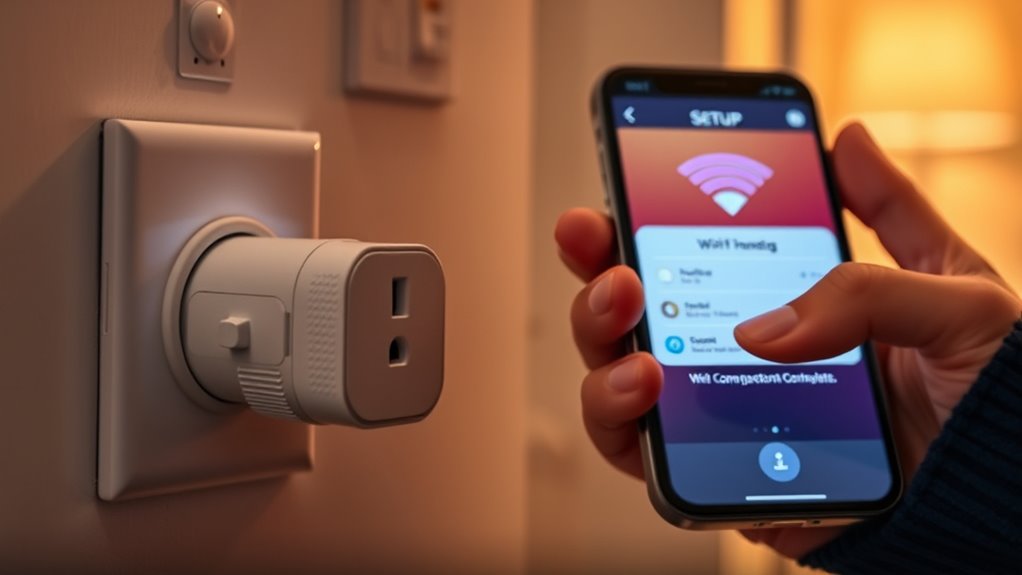
Connecting your energy monitoring plug to your Wi-Fi network is a straightforward process that guarantees you can control and monitor your device remotely. First, ensure your Wi-Fi has a strong signal, as poor signal strength can cause connection issues. Keep your Wi-Fi password handy, and make sure your network uses secure Wi-Fi security protocols to protect your device. Open the app recommended by the manufacturer and follow the prompts to add your plug. During setup, select your Wi-Fi network and enter the password. The plug will attempt to connect; if it fails, check your signal strength and Wi-Fi security settings. Once connected, you’ll be able to control your device remotely and monitor its energy usage securely.
Configuring the Device Settings and Preferences
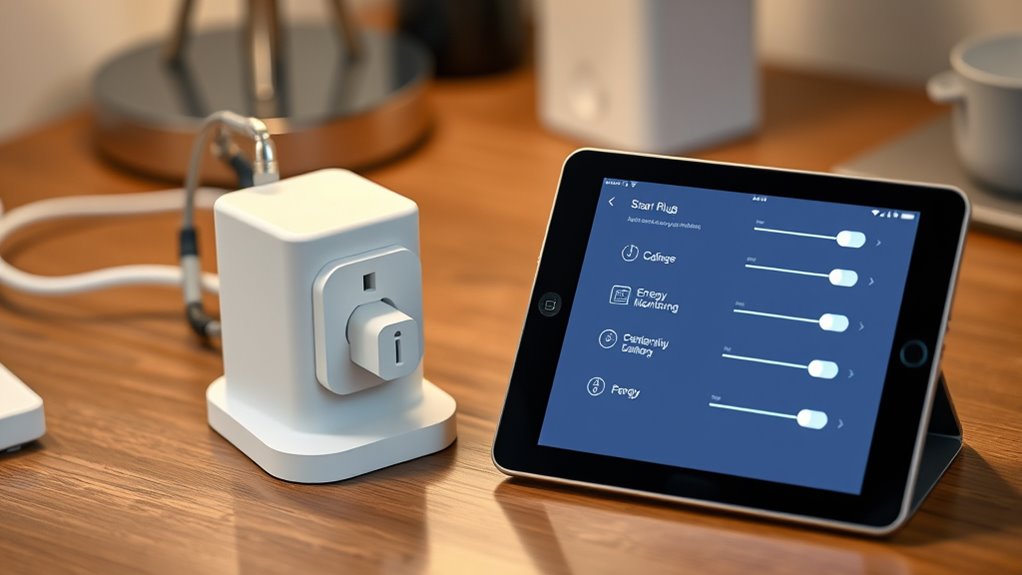
Once your energy monitoring plug is connected to Wi-Fi, you can begin customizing its settings to suit your needs. Focus on optimizing device ergonomics for easier control and access. You should also regularly check for firmware updates to improve functionality and security. Here are the key steps:
- Adjust device preferences such as power thresholds and scheduling options for better energy management.
- Review and optimize device ergonomics by repositioning controls or changing interface settings for easier use.
- Keep firmware updated through the app to ensure your device runs smoothly and benefits from the latest features.
Taking these steps helps personalize your experience, enhances device performance, and keeps your energy monitoring plug secure and efficient.
Monitoring Your Energy Usage and Interpreting Data
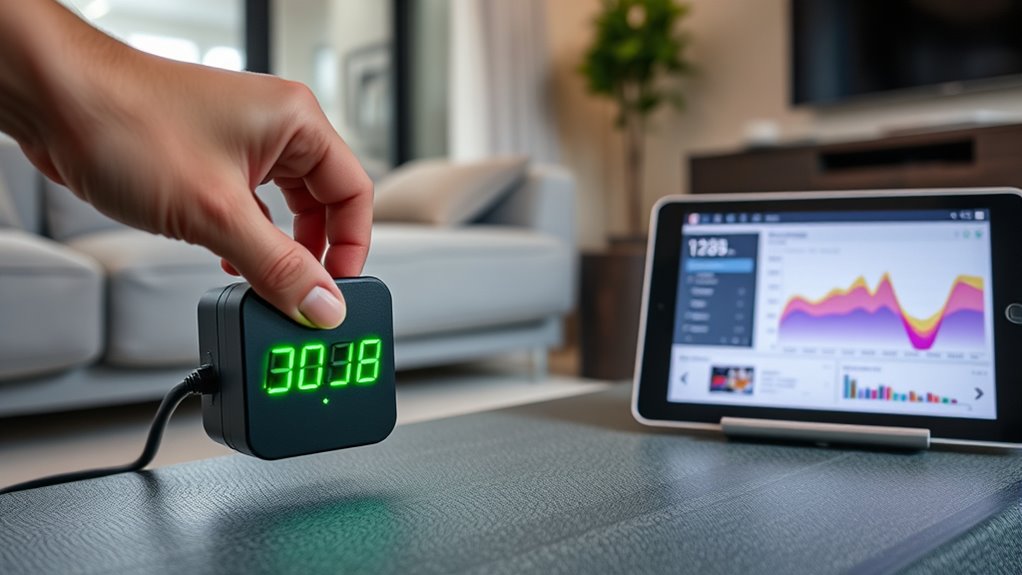
After customizing your device settings and ensuring your energy monitoring plug is up to date, you can start actively tracking how much energy your appliances use. Monitoring your energy usage gives you real-time data on each device’s energy consumption, helping you identify high-energy appliances or unusual patterns. To interpret this data, focus on understanding daily, weekly, or monthly usage trends. Look for spikes or consistent energy drains, which could indicate inefficiencies or faulty devices. Data analysis allows you to make informed decisions about reducing energy waste and lowering costs. By regularly reviewing your energy consumption patterns, you gain insights into how your household uses power, empowering you to implement effective energy-saving strategies and optimize your overall energy efficiency.
Tips for Maximizing Energy Savings and Troubleshooting
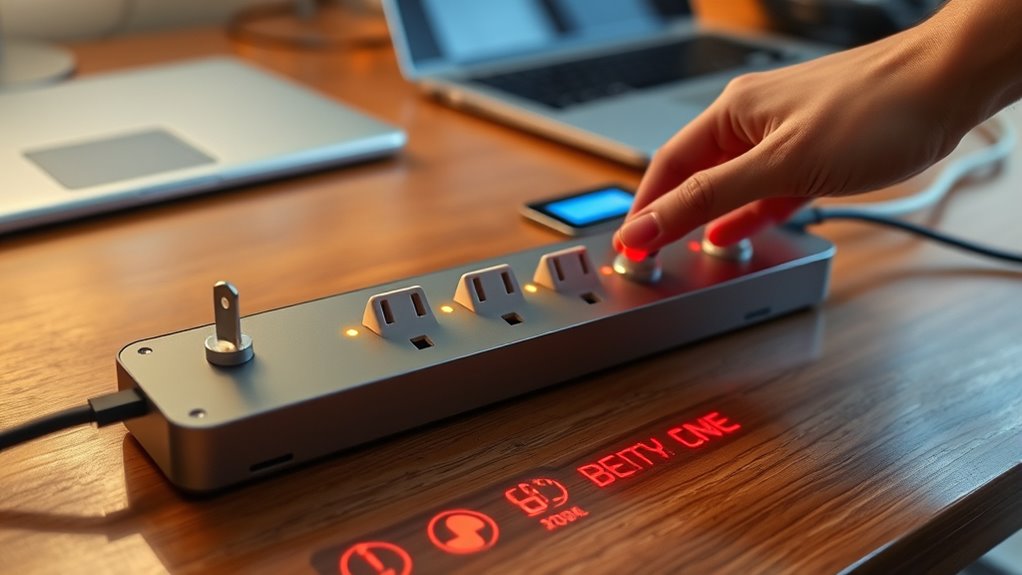
To maximize your energy savings, start by setting realistic goals based on your monitored usage data and adjusting device settings accordingly. Incorporate power saving strategies like turning off unused devices and enabling energy-saving modes. Here are some troubleshooting tips to keep your energy monitoring plugs working efficiently:
- Check connections if readings are inconsistent or unresponsive.
- Reset devices periodically to clear glitches affecting accuracy.
- Update firmware or app software to access new features and improve performance.
Frequently Asked Questions
Can Energy Monitoring Plugs Work With All Smart Home Systems?
You might wonder if energy monitoring plugs work with all smart home systems. Usually, they don’t due to compatibility issues and integration challenges. Some plugs only work with specific platforms like Alexa or Google Assistant, while others may support multiple systems. To avoid problems, check the device’s compatibility before purchasing, and guarantee it can integrate smoothly with your existing smart home setup. This way, you’ll enjoy seamless energy monitoring.
How Long Does It Take to Fully Set up an Energy Monitoring Plug?
Ever wondered how long it takes to fully set up an energy monitoring plug? Usually, the installation time is quick, taking about 10 to 15 minutes. You just need to connect it to a compatible device, verify it’s Wi-Fi enabled, and sync it with your smart home system. Device compatibility is key—most plugs work with popular platforms, making setup straightforward and hassle-free. Isn’t it great to monitor energy use in just minutes?
Are There Safety Concerns When Installing These Devices?
When installing energy monitoring plugs, you should consider electrical safety and device compatibility. Guarantee the plug matches your outlet type and supports the device’s power requirements. Always follow manufacturer instructions, avoid overloading outlets, and unplug devices during installation. If unsure, consult a professional. Proper installation minimizes risks like electrical shocks or fires, keeping your setup safe while ensuring your energy monitoring devices work effectively and reliably.
What Is the Typical Lifespan of an Energy Monitoring Plug?
The typical lifespan of an energy monitoring plug depends on its device durability and usage. Usually, these devices last around 3 to 5 years, but factors like frequent plugging and unplugging, power surges, or poor build quality can shorten their replacement intervals. You should monitor their performance regularly; if you notice malfunctions or inconsistent readings, it’s time to replace the device to guarantee safety and accuracy.
Can I Use Multiple Plugs to Monitor a Single Device?
Yes, you can use multiple plugs to monitor a single device, which helps you better understand power management. By plugging different parts of a device into separate energy monitoring plugs, you can track how each component uses power. This setup allows you to identify power-hungry elements, optimize usage, and improve overall efficiency. Just guarantee your plugs are compatible and connected properly to avoid any overloads or data inaccuracies.
Conclusion
Now that you’ve set up your energy monitoring plug, you’re all set to keep a close eye on your energy use. Regularly review your data to spot savings opportunities and make smarter choices. If you hit a snag, don’t be afraid to troubleshoot or revisit your settings. Remember, patience pays off—staying proactive helps you squeeze the most out of your new device and keeps your energy bills in check.
